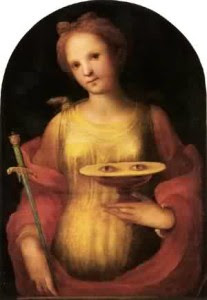By Professor Carol on Dec 13, 2014 03:00 am

St. Lucy – Domenico di Pace Beccafumi
Lucy, Lucia, Lux – it means “light,” and a celebration of light is certainly appropriate to Advent. And nowhere can we find a greater celebration of light than the feast of St. Lucia in Sweden, where winter rules the day with darkness.
Yet, Lucia was actually a young Sicilian girl, a girl from “sunny Italy.” Martyred in the 4th century, most of the art depicting her shows her holding a dish with two eyes on it. Parents with younger kids can research the stories about St. Lucia’s plight, and decide what to share with your children!
Saint Lucia’s Day is celebrated on December 13. Now if you enjoy math, astronomy, and history, you can figure out when the winter solstice (the darkest day of the year) would have occurred on the old Julian calendar and how the feast of St. Lucy used to fall on a day even shorter than the 13th.
If you live in the far Northern Hemisphere, say in Sweden, the darkest day of the year is quite dark indeed. The sun will rise in Stockholm at about 9:00 a.m. and set at 3:00 p.m. It’s not surprising that Scandinavians have a particular affinity for Saint Lucy.
So what does Philadelphia have to do with any of this? That’s quite simple, really. Philadelphia is home to Gloria Dei Old Swedes’ Church, founded by Swedish Lutherans in 1646. It is the second oldest church in continuous use in the United States (the oldest being the Old Swedes’ Church in nearby Wilmington, Delaware).
Today, Gloria Dei occupies a peaceful oasis in inner-city Philadelphia. Its rich history attracted me as I was planning my program on American music – Exploring America’s Musical Heritage, but I could not have anticipated finding such a wonderful and generous group of people as we did in that parish. They have several stories to tell in that program, and their celebration of Saint Lucy’s Day is just one of them.
|
No comments:
Post a Comment